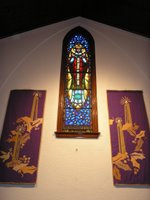
Do you seek to bring a sense of life and color to your worship space to enhance and expand worshipers’ perception of the reality and grace of God? Worship banners are a form of artistic expression that can do just that. Banners have a long established tradition is churches. Well-designed banners are an effective means toward the enhancement of worship both because of their visual appeal and because they can be continually changed in color and symbolism to represent the progression of the calendar of the Church year.
Whether the banners are to be in a small or grand scale there are several components to think about so you can obtain your goal. Who will make the banners? Banners can be created by teams of people gifted with artistic and textile construction skills. Artists can be commissioned to create banners. Children can also create banners under well planned adult guidance. Secondly, decide if the banners will hang for a short or long period of time. This will help dictate the type of materials used because anything from butcher block paper to magnificent brocade fabric has potential. Thirdly, examine and measure the space the banners will hang in. Proportion to the architecture is key to helping the banners function direct attention to God. It would not be appropriate for the banners to call attention to them or be present for their beauty as an end to themselves.
May your church banners echo the psalmist who declared, “O Lord, our Lord, how majestic is they name in all the earth!” (Psalm 8:9)
*angels are a detail from new banners created by Carrot Top Studio for a parish in Michigan.
Whether the banners are to be in a small or grand scale there are several components to think about so you can obtain your goal. Who will make the banners? Banners can be created by teams of people gifted with artistic and textile construction skills. Artists can be commissioned to create banners. Children can also create banners under well planned adult guidance. Secondly, decide if the banners will hang for a short or long period of time. This will help dictate the type of materials used because anything from butcher block paper to magnificent brocade fabric has potential. Thirdly, examine and measure the space the banners will hang in. Proportion to the architecture is key to helping the banners function direct attention to God. It would not be appropriate for the banners to call attention to them or be present for their beauty as an end to themselves.
May your church banners echo the psalmist who declared, “O Lord, our Lord, how majestic is they name in all the earth!” (Psalm 8:9)
*angels are a detail from new banners created by Carrot Top Studio for a parish in Michigan.





